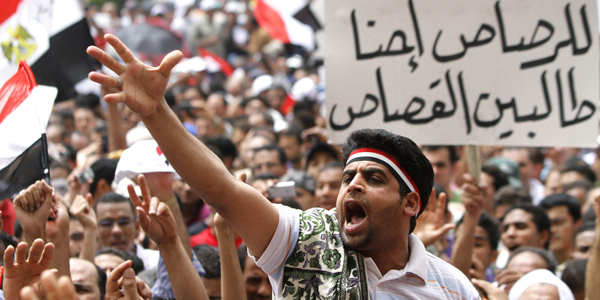The Revolution Pushes On
CAIRO, Egypt — The Egyptian uprising that began on January 25 has yet to reach its zenith. Many an acerbic observer has noted that so far it has yielded little more than a personnel change in a military dictatorship. That same cynicism, of course, misled many Egypt-watchers when the protests first began, discount the potential of people power to force change. Oddly, the same demerits summoned then are now cited as proof that Egypt has not really witnessed a revolution or that its revolution is in disarray. The main allegations: the popular movement against the regime lacks a leader and a coherent plant; it relies too much on elites; its criticisms of the military will alienate most Egyptians, who just seek stability; and that the military is more firmly entrenched in power than ever before.
Consider the significance of Friday, when one of the largest protests in Tahrir in months drew the full, preemptory wrath not only of the military junta, but of the Muslim Brotherhood. The Supreme Council of the Armed Forces, or SCAF, addressing the multitudes in the traditional intimidating rhetoric of Egypt’s ruling class but through the modern vehicle of its Facebook page, warned about “suspicious forces conducting acts that will cause tension between the Egyptian people and the armed forces.” Several activists, including a trio of artists, had been arrested the week before while promoting the march, and the military ominously warned it would stay away from Tahrir, and that thugs might run rampant. This last declaration was taken as a hint that the military might be reviving one of the regime’s oldest tricks, pulling security off the street and then deploying its own paid baltagaya to beat and harass dissidents.
For its part, the Brotherhood, the only formidable political organization outside the state, has shown itself cynically willing to play footsie with the junta while discrediting its erstwhile revolutionary confreres. “At whom is the anger directed?” the Brotherhood leadership asked in a patronizing statement in which it explained why it would boycott the May 27 Tahrir protest, which it viewed as an unacceptable rebuke toward the military — or what it considers the unassailable sentiments of the “majority” of the Egyptian people.
These are old tropes, echoing a favored ploy of Mubarak, his predecessors, and many of his surviving colleagues in the fraternity of Arab dictators: if you want stability, behave and do as we tell you — otherwise, drown in chaos.
The youth leaders who galvanized the May 27 protest are anything but uniform or centrally organized. They included leftists, socialists, nationalists, and Islamists. The only thing they shared in common is a belief that mass protests have proven the only effective tool in winning concessions from the SCAF. Beyond that, their platforms and styles diverge. Leaders of the April 6 youth group are concentrating on a program of public outreach to convince Egyptians that only an end to de facto military rule can save the economy and their livelihoods. Many of the liberals have their eyes on upcoming elections, and are jockeying their newly formed parties for position, or arguing about the correct order for a transition: elections first, then a constitution, as the military suggests? Or vice versa? Muslim Brotherhood youth leaders brought out hundreds of their own members in solidarity and to tell their own leaders that the organization cannot function internally as a dictatorship.
Gaping questions face the revolutionary movement going forward. Can it force the military to back down on current practices that include censoring the media, trying civilians in military courts, drawing the rules for elections and political party formation by fiat, all while allowing the police to stay home and the economy to drift?



[…] will lead to increased extremism and terrorism in the region. There is much concern that the revolution is incomplete in Egypt, with the possibility of a quick elections either returning the military government or will lead to […]